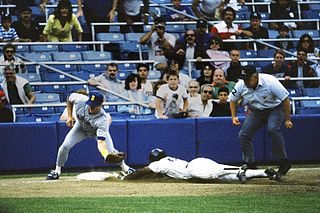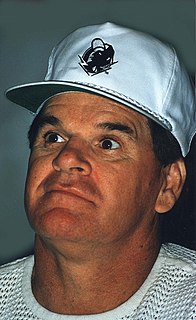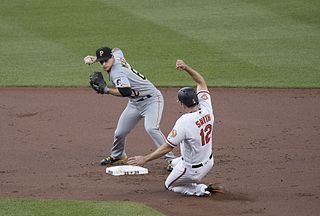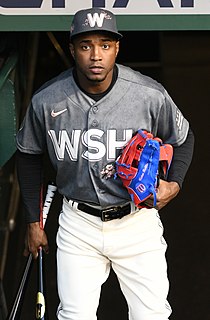Baseball statistics play an important role in evaluating the progress of a player or team.

In baseball statistics, a hit, also called a base hit, is credited to a batter when the batter safely reaches or passes first base after hitting the ball into fair territory, without the benefit of either an error or a fielder's choice.

In baseball, a stolen base occurs when a runner advances to a base to which they are not entitled and the official scorer rules that the advance should be credited to the action of the runner. The umpires determine whether the runner is safe or out at the next base, but the official scorer rules on the question of credit or blame for the advance under Rule 10 of the MLB's Official Rules.

In baseball, a home run is scored when the ball is hit in such a way that the batter is able to circle the bases and reach home plate safely in one play without any errors being committed by the defensive team. A home run is usually achieved by hitting the ball over the outfield fence between the foul poles without the ball touching the field. Far less common is the "inside-the-park" home run where the batter reaches home safely while the baseball is in play on the field.

In baseball, a single is the most common type of base hit, accomplished through the act of a batter safely reaching first base by hitting a fair ball and getting to first base before a fielder puts him out. As an exception, a batter-runner reaching first base safely is not credited with a single when an infielder attempts to put out another runner on the first play; this is one type of a fielder's choice. Also, a batter-runner reaching first base on a play due to a fielder's error trying to put him out at first base or another runner out is not credited with a single.

In baseball, a double is the act of a batter striking the pitched ball and safely reaching second base without being called out by the umpire, without the benefit of a fielder's misplay or another runner being put out on a fielder's choice. A double is a type of hit and is sometimes called a "two-bagger" or "two-base hit". For statistical and scorekeeping purposes it is denoted by 2B.

In baseball and softball, a double play is the act of making two outs during the same continuous play. Double plays can occur any time there is at least one baserunner and fewer than two outs.

In baseball statistics, an error is an act, in the judgment of the official scorer, of a fielder misplaying a ball in a manner that allows a batter or baserunner to advance one or more bases or allows a plate appearance to continue after the batter should have been put out. The term error is sometimes used to refer to the play during which an error was committed.

A first baseman, abbreviated 1B, is the player on a baseball or softball team who fields the area nearest first base, the first of four bases a baserunner must touch in succession to score a run. The first baseman is responsible for the majority of plays made at that base. In the numbering system used to record defensive plays, the first baseman is assigned the number 3.

Samuel James Tilden Sheckard was an American left fielder and left-handed leadoff hitter in Major League Baseball who played for the Brooklyn Bridegrooms/Superbas, Baltimore Orioles (NL) (1899), Baltimore Orioles (AL) (1902), Chicago Cubs (1906–12), St. Louis Cardinals (1913) and Cincinnati Reds (1913).

The rules of baseball differ slightly from league to league, but in general share the same basic game play.

Baseball scorekeeping is the practice of recording the details of a baseball game as it unfolds. Professional baseball leagues hire official scorers to keep an official record of each game, but many fans keep score as well for their own enjoyment. Scorekeeping is usually done on a printed scorecard and, while official scorers must adhere precisely to one of the few different scorekeeping notations, most fans exercise some amount of creativity and adopt their own symbols and styles.

William Henry Davis was a center fielder in Major League Baseball who played most of his career for the Los Angeles Dodgers. At the end of his career he ranked seventh in major league history in putouts (5449) and total chances (5719) in the outfield, and third in games in center field (2237). He was ninth in National League history in total outfield games (2274), and won Gold Glove Awards from 1971 to 1973. He had 13 seasons of 20 or more stolen bases, led the NL in triples twice, and retired with the fourth most triples (138) by any major leaguer since 1945. He holds Los Angeles club records (1958–present) for career hits (2091), runs (1004), triples (110), at bats (7495), total bases (3094) and extra base hits (585). His 31-game hitting streak in 1969 remains the longest by a Dodger. When he tied Zack Wheat's previous record at 29 games, the message board at Dodger Stadium flashed a message sent via telegram by Wheat from his home in Missouri, saying, "Congratulations. Keep going. You have done a good job. Good luck."
This is an alphabetical list of selected unofficial and specialized terms, phrases, and other jargon used in baseball, along with their definitions, including illustrative examples for many entries.

Víctor Enrique Robles Brito is a Dominican professional baseball outfielder for the Washington Nationals of Major League Baseball (MLB). Robles signed with the Nationals as an international free agent in 2013. He made his MLB debut in 2017.














